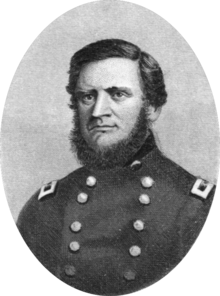George W. Morgan
George Washington Morgan | |
|---|---|
United States Ambassador to Portugal | |
| In office 1858–1861 | |
| Preceded by | John L. O'Sullivan |
| Succeeded by | James E. Harvey |
| Personal details | |
| Born | September 20, 1820 United States of America Union |
| Branch/service | United States Army Union Army |
| Years of service | 1846–1848, 1861–1863 |
| Rank | |
| Commands | 15th Infantry Regiment |
| Battles/wars | Mexican War
|
George Washington Morgan (September 20, 1820 – July 26, 1893) was an American
Early life and career
Morgan was born in Washington County, Pennsylvania, to a prominent family. His grandfather, Col. George Morgan, was the first to give President Thomas Jefferson the information regarding Aaron Burr's conspiracy.[1] G. W. Morgan was educated in local schools, and then in 1836, he withdrew from Washington College at the age of 16 and enlisted in a military company that was commanded by his older brother, Thomas Jefferson Morgan. They traveled south to Mexican Texas to fight in the struggle for independence from Mexico. Morgan received a commission in the regular Texas Army under Sam Houston as a lieutenant, and rose to captain commanding the post at Galveston. He served with Captain Robertson's rangers and Company B of the First Regiment of Texas Rangers. He resigned in 1839 to return to Pennsylvania.[2]
In 1841, he entered the United States Military Academy, but left in 1843 due to poor grades. He moved to Mount Vernon, Ohio, studied law, passed the bar exam, and established a law practice there in 1845. He served as prosecutor for Knox County.
When war erupted with Mexico, Morgan was appointed
Morgan resumed his law practice in Mount Vernon. He married Sarah H. Hall of Zanesville, Ohio, on October 7, 1851, and they had two children.[2]
He was a lawyer until 1856, when he was appointed by President
Civil War

Morgan, due to his previous military experience in two wars, was appointed as a brigadier general in the
However, in September, he was forced to hastily retreat towards the Ohio River as Braxton Bragg invaded Kentucky, cutting off his supply routes. Morgan conducted a masterful retreat in the face of the much superior enemy force, despite being harassed by constant attacks from Col. John H. Morgan's guerrillas. George Morgan's 8,000 men marched over 200 miles from Cumberland Gap in sixteen days to Greenup, Kentucky, arriving there on October 3 on their way to Camp Dennison in Ohio.[4]
In November, Morgan served with Maj. Gen.
The following year, Morgan commanded the 3rd Division of the
Later life and political career

While strongly in favor of maintaining the
Nonetheless, he continued to pursue a political career, and in 1866 was elected to the
Retirement and death
Following his retirement from Congress, Morgan was a delegate-at-large to the 1876
He died at Fort Monroe, Virginia on July 26, 1893, the last surviving general of the Mexican-American War.[1][6] He was buried in Mound View Cemetery in Mount Vernon, Ohio.
See also
Notes
- ^ a b c The National Cyclopaedia of American Biography. Vol. IV. James T. White & Company. 1893. p. 71. Retrieved December 2, 2020 – via Google Books.
- ^ a b c Handbook of Texas Online
- ^ Newark Daily Advocate, August 18, 1900, Newark, Ohio
- ^ "Kentucky Historical Society". Archived from the original on September 27, 2007. Retrieved October 4, 2006.
- ^ Appletons Cyclopedia
- The Standard Union. Cleveland, Ohio. July 27, 1893. p. 4. Retrieved December 2, 2020 – via Newspapers.com.
References
- Handbook of Texas Online
- Kentucky Historical Society - roadside markers for Morgan's Retreat Archived September 27, 2007, at the Wayback Machine
- Newark, Ohio, Daily Advocate, August 18, 1900.
- Ohio in the War Her Statesmen Generals and Soldiers. Vol. 1. Cincinnati: The Robert Clarke Company. p. 923.
- Attribution
 This article incorporates text from a publication now in the public domain: Wilson, J. G.; Fiske, J., eds. (1891). Appletons' Cyclopædia of American Biography. New York: D. Appleton.
This article incorporates text from a publication now in the public domain: Wilson, J. G.; Fiske, J., eds. (1891). Appletons' Cyclopædia of American Biography. New York: D. Appleton. {{cite encyclopedia}}: Missing or empty|title=(help)
Further reading
- Asbury, Samuel E., ed., "Extracts from the Reminiscences of General George W. Morgan," Southwestern Historical Quarterly 30 (January 1927).
External links
 Media related to George W. Morgan at Wikimedia Commons
Media related to George W. Morgan at Wikimedia Commons
- United States Congress. "George W. Morgan (id: M000950)". Biographical Directory of the United States Congress. Retrieved on 2008-08-13
- Smithsonian Institution collection - photo of Morgan's Mexican-American War flintlock pistol
- "George W. Morgan". Find a Grave. Retrieved August 13, 2008.

